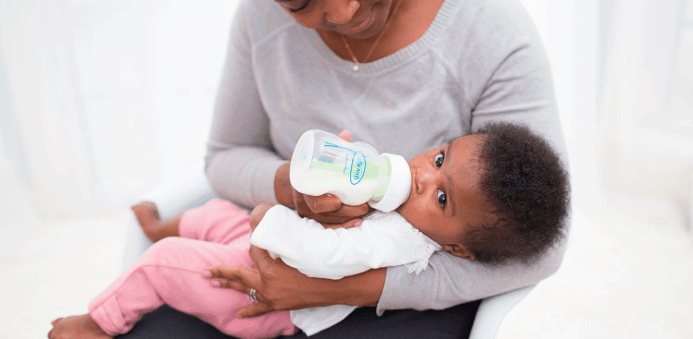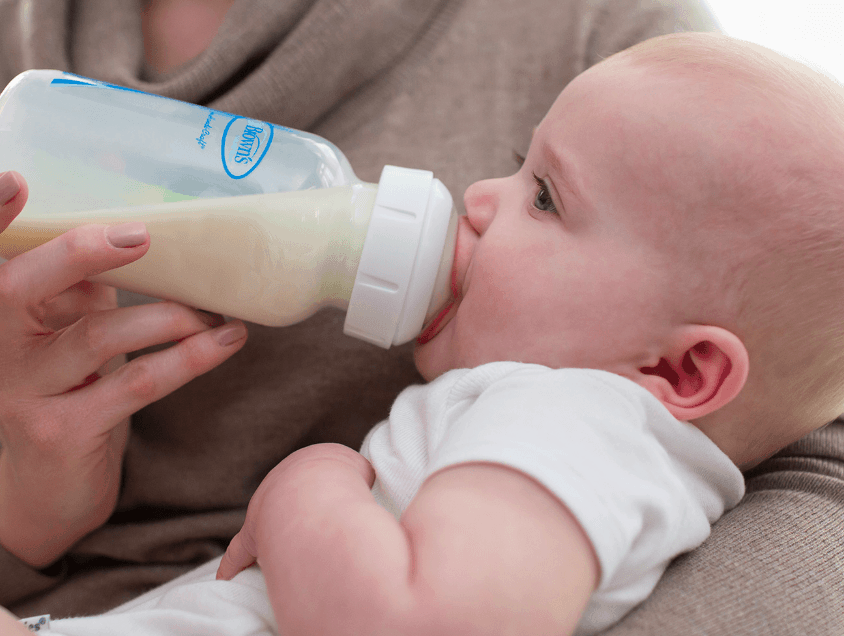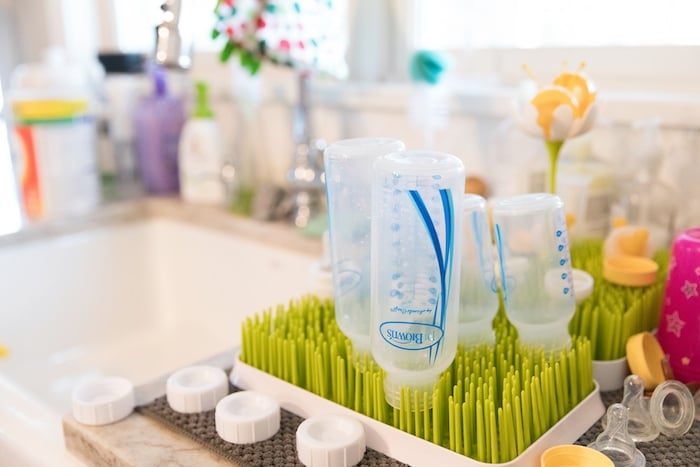Last updated on March 11th, 2024 at 12:42 pm
Read below for tips for bottle feeding a breastfed baby, brought to you by our friends at Dr. Brown’s.
You! Are! The! Luckiest! Your options have never been better with Dr. Brown’s Natural Flow® Options+™ Wide-Neck Bottle. These revolutionary bottles — a Twinnie Award winner — are some of the best out there for mamas and papas, oh and your twinnies too of course!
From nipple to base, Dr. B’s Options+ Wide-Neck Bottle makes for a comfortable feeding experience for your twinnies and eases the transition from breast to bottle AND bottle to breast when bottle feeding a breastfed baby.
Starting at the top, each nipple is specially engineered to offer the same consistent, natural flow, so you and baby know what to expect in every feeding. The NEW breast-like nipple shape (have you seen these yet?) is correctly contoured for a proper latch and a more natural bottle-feeding experience – perfect for switching from breast to bottle and back again!
TIP FROM OUR RESIDENT CLC, Natalie Diaz: Make sure you that you introduce your baby to a bottle by the 4th week even if you plan on exclusively breastfeeding. At some point, you’ll probably want to sleep more than 4 hours, and having an alternative feeding method will save your day.
Together with the anti-colic internal vent system, your Twinnies will feed without fuss. But it doesn’t stop there. The anti-colic internal vent system features an enhanced design to improve an already innovative feeding experience:
- Clinically proven to reduce colic
- Decreases spit-up, burping, and gas
- Shown to better preserve nutrients in breast milk and formula
- Aids in digestion for a good night’s sleep
- Offers a flow rate that supports breastfeeding.
Just so you know, their bottles work best with the vent system in place – but it’s great to have options when baby’s feeding develops. Just remove the vent when you feel it’s time – no need to introduce a different bottle. See, the vent system isn’t the only means of venting in the Options+™ bottle. Their bottle nipples feature their own venting system that offers a feeding experience similar to most nipple-vented bottles.
Options+™ is dishwasher (top rack) and sterilizer safe. BPA free. 0m+.
Bottle Feeding a Breastfed Baby
If your twins are rocking with breastfeeding and you’re ready to introduce a bottle, we have a few tips to share that will truly make your transition easier.
But why would you WANT to start bottle feeding a breastfed baby if things are going so well with breastfeeding? Well, for starters, wouldn’t it be nice to have someone else feed them once in a while? You could probably use a break now and then and bottle feeding will allow you a lot more freedom. Also, you may be planning to go back to work and how soon you can get your babies to take a bottle will factor in how easy your transition back to work will be.
In addition, the transition to a bottle is easier if you start earlier when your babies are more flexible. If you wait too long to introduce a bottle you may miss that window and it will be more difficult to bring a bottle into the mix months later. Bottle feeding a breastfed baby takes some nuance, patience, and a few tricks up your sleeve, so take a look at our suggestions and we wish you a happy feeding.

What Nipple Should We Start With?
Most baby bottles come standard with a Level 1 nipple. This is the nipple with the slowest flow that will more closely resemble breastfeeding. Continue using this Level 1 nipple even after baby has gotten used to the bottle. If you move to a higher level nipple (with a faster flow) too soon, you may run the risk of your baby starting to prefer the bottle over the breast. We want baby to not prefer one over the other, so keep the milk flowing slow and steady when bottle feeding a breastfed baby.
What Bottle Is Best for a Breastfed Baby?
There are baby bottles on the market that were designed to be used with babies who also breastfeed. These bottles use nipples that are shaped to more closely resemble a woman’s breast and nipple. Read the user reviews on bottles that claim to be better for breastfed babies and select 2 or 3 to try out. Once you find one that really works for your babies, then make the investment in more bottles. Heads up — your twins may prefer two different bottles, and that’s OK. Get what works best for each of them, which may mean two different brands.
Should I Worry About the Temperature of Milk or Formula?
Since you are already breastfeeding, it’s recommended to start a using a bottle with pumped breastmilk for an easier transition (you can introduce formula later.) Warm up the breastmilk to try matching the temperature the baby is used to while nursing. You can use a bottle warmer or place the bottle in a warm water bath. Never use a microwave to warm a bottle, as it will heat the milk inconsistently and you run the risk of it being too hot in certain spots.
When Should I Introduce a Bottle to My Baby?
There are mixed recommendations on the perfect timing to introduce a bottle. Many lactation consultants (LC) agree that around 4 weeks old is a good time to start bottle feeding a breastfed baby, which is typically the time when breastfeeding is well established. But you can start earlier than that if you feel that breastfeeding is going well. However, most LCs recommend no earlier than 2 weeks so baby doesn’t start preferring the bottle over the breast (using a paced bottle feeding technique will help with this.)
If you wait several months before introducing a bottle you will probably have a more difficult time because your babies will be used to the breast and less flexible towards any changes. Aiming for around 4 weeks old will allow you the flexibility to go back and forth between breast and bottle and give you the freedom to allow someone else to feed the babies.
That doesn’t mean that if you only use a bottle in the first two weeks of life that your babies will never breastfeed, so please don’t panic. Many babies who start on a bottle (such as NICU babies) go on to breastfeed later. It all depends on the mom. If mom wants to breastfeed and her milk is flowing but her babies are unable to nurse just yet, getting on a pumping routine will be critical to make sure the milk is flowing when babies are physically able to nurse.

Who Should Feed My Baby if I Can’t?
When you first introduce a bottle to a breastfed baby, it’s easier to get them to take the bottle if it’s not mom trying to do it. In fact, if you can leave the house, even better. If baby can smell you in the house they will know you’re nearby and cry for you. Having someone else do it, such as your partner or other caregiver, while you’re 2-3 rooms away (or at Starbucks down the street!) takes some of the pressure off and the baby may take the bottle more willingly. Another reason to leave the house is that you’ll remove that temptation to jump in and take over if your baby is fussing.
When Is the Best Time to Feed a Baby?
Introduce a bottle after your baby’s hunger is satiated. One way to do this is to nurse your baby for about 10 minutes, pass the baby off to your partner or caretaker and leave the room (a pacifier is helpful at this moment), and then they feed the baby with a warmed bottle. This way your baby is not starving and will be a lot calmer when taking the bottle. Another trick is to dab a little breastmilk on top of the nipple to get your baby interested.
What if My Baby Doesn’t Want a Bottle?
Some babies take longer to get used to a bottle. Some moms report that it took them 2-3 weeks to get their babies to take a bottle. Go into this with the expectation that it will take longer than you expect and maybe you’ll be surprised. If you offer a bottle and they aren’t interested, try again tomorrow. If you’re planning to go back to work soon, give yourself 4 weeks minimum to make the transition.
We hope these tips help your transition to bottle feeding a breastfed baby. Be consistent and stay the course and you’ll get those twinnies bottle feeding in no time.









